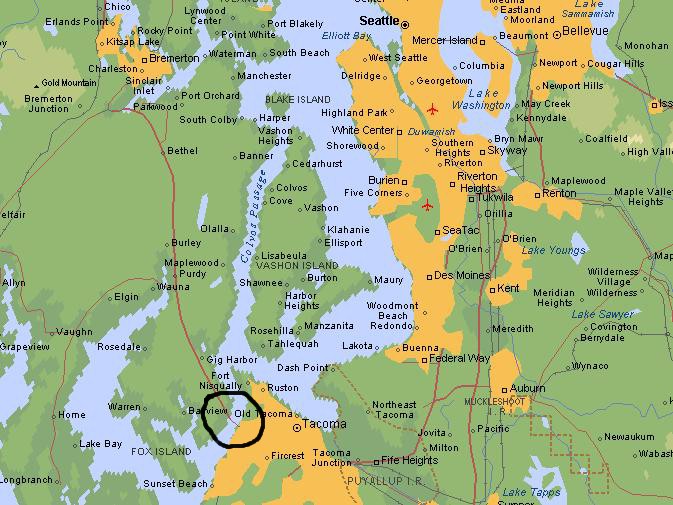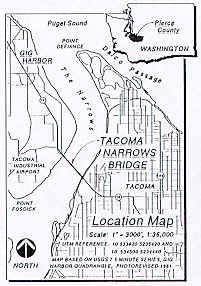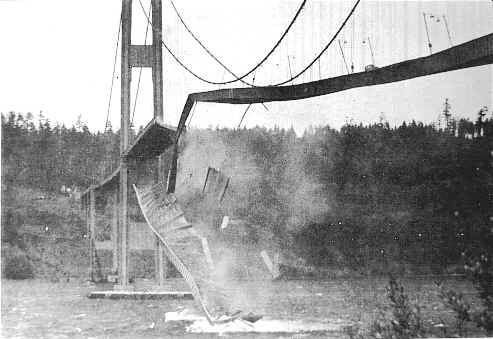The Tacoma Narrows is the single point in the 20,000 square miles
of Puget Sound where the Washington mainland and the Olympic
Peninsula are close. For years, it had been clear to State
officials that the Narrows would have to be bridged in order
to open up the spectacular and thinly populated Peninsula. Aware
of this situation, the Washington State Legislature created the
Washington Toll Bridge Authority in 1937, with a mandate to finance,
construct and operate toll bridges.
The legislature appropriated $25,000 to study the request. Satisfied
with the results of the study, on May 23, 1938, the State of
Washington submitted an application to the Public Works Administration
(PWA) requesting funds for construction of a bridge.
Between the time the state legislature authorized the money to study
the proposal and the completion of that study, Lacey Murrow, Director
of the Washington State Department of Highways, had given Clark
Eldridge, a bridge engineer with the department, the green light to
design a bridge to span the Narrows. Eldridge’s plan called for a
5,000 foot, two-lane suspension bridge. When completed, the structure
would be the third longest suspension bridge in the world.
After examination of Eldridge's plans in May of 1938, the Public
Works Administration agreed to finance 45 percent of the construction,
provided that the State of Washington retain a board of independent
engineering consultants to reexamine Eldridge's design. The State
complied and employed the firm of Moran and Proctor to study the
plans for the substructure. Furthermore, the State retained Leon
S. Moisseiff, the world-renowned suspension bridge builder to
examine the plans concerning the superstructure. Both Moran and
Proctor and Moisseiff made significant alterations to Eldridge's
original design. Specifically, Moran and Proctor wanted an
entirely different substructure. As to Moisseiff, he substituted
the 25 foot deep open stiffening truss with an eight foot, shallow
plate girder, resulting in a much lighter bridge.
Prior to the opening of the construction bids, a group of contractors
notified the engineers they could not meet the specifications for
the substructure. As a result, Moran and Proctor's plans for the thicker
substructure were scrapped, and Eldridge's original plans for the
substructure were reintroduced. After consultation with Moisseiff,
it was agreed that Eldridge's design for the substructure would be
used in conjunction with Moisseiff's plans for the thinner superstructure.
This modified plan was approved by the Public Works Administration
and bids for construction were opened on September 27, 1938. The
Pacific Bridge Company's low bid of $5,594,730.40 was accepted.
The Bethlehem Steel Company was an associate contractor that
supplied and erected the steel and wire. Work on the bridge
began in early 1939 and on July 1, 1940, the $6.4 million bridge
opened and the link between the Washington mainland and the
Olympic Peninsula was complete.
The first Tacoma Narrows Bridge was revolutionary in its design.
Since the turn of the century, suspension bridge construction had
valued structural grace and slenderness to achieve an artistic
appearance. With its shallow stiffening trusses and slender towers,
the bridge across the Narrows was the epitome of artistry in bridge
construction.
But its failure on November 7, 1940 marked the end of a trend in
bridge engineering towards a maximum of lightness, grace and
flexibility.
The slender and graceful Tacoma Narrows Bridge became known for its
tendency to sway in windstorms. The shape of the bridge was much
like that of an aircraft wing and under windy conditions it would
generate sufficient lift to become unstable.
Vertical oscillations of the roadbed occurred even during the
construction phase and raised questions about the structure's
stability. Some breezes as low as four miles per hour caused
oscillations, while stronger breezes often had no effect. Prior
to the bridge's opening, hydraulic buffers were installed at
the towers to control the stresses. The undulations continued,
however, and further studies were undertaken at the University
of Washington. Their recommendation of the installation of
tie-down cables in the side spans were implemented, but to
little effect.
Local folks lost no time in nicknaming the bridge "Galloping
Gertie." Fascinated by Gertie, thousands of people drove
hundreds of miles to experience the sensation of crossing
the rolling center span. The disappearance and then reappearance
of cars from the sight of those standing at the ends of the
bridge often highlighted the experience. For four months, the
Washington Toll Bridge Authority thrived as traffic had trebled
from what had been expected. Although concerns about the bridge's
stability had been voiced, bridge officials were so confident
of the structure, they considered canceling the insurance policies
in order to obtain reduced rates on a new one.
But throughout the early morning hours of Thursday, November 7, 1940,
the center span had been undulating three to five feet in winds
of 35 to 46 miles per hour. Alarmed by this constant motion,
highway officials and state police closed the bridge at 10:00 A.M.
Shortly thereafter the character of the motion dramatically changed
from a rhythmic rising and falling to a two-wave twisting motion.
The twisting motion grew stronger with each twist; span movement
had gone from 5 foot to 28 foot undulations. This twisting motion
caused the roadbed to tilt 45 degrees from horizontal one way and
then 45 degrees from horizontal the other way at approximately one
third the speed shown below.
|
For about 30 minutes, the center span endured the twisting. At about
10:30 A.M., the windstorm caused severe and catastrophic
failure of the bridge's thin deck. Once the structural integrity was
compromised major portions of the bridge deck began to fall into
the Tacoma Narrows channel. A center span floor panel dropped into
the water 195 feet below. The roadbed was breaking up, and chunks
of concrete were raining into the Sound. At 11:02 A.M., 600 feet
of the western end of the span twisted free, flipped over, and
plunged down into the water. Engineers on the scene hoped that
once this had happened, the remainder of the span would settle down.
The twisting continued, however, and at 11:09 A.M., the remaining
bridge sections ripped free and thundered down into the Sound.
When this happened, the 1,100 foot side spans dropped 60 feet,
only to bounce up and then settle into a sag of 30 feet. As for
the center span, it rested on the dark and tide-swept bottom of
the Narrows.
When the collapse happened, there was one car trapped on the bridge
with its driver and his dog, Tubby. Notice the unfortunate car on
the bridge deck in the upper right corner of this picture. The
driver finally staggered along the bridge to safety, but the dog
could not be coaxed to leave the car, and was the only fatality of the
bridge's collapse.
|





